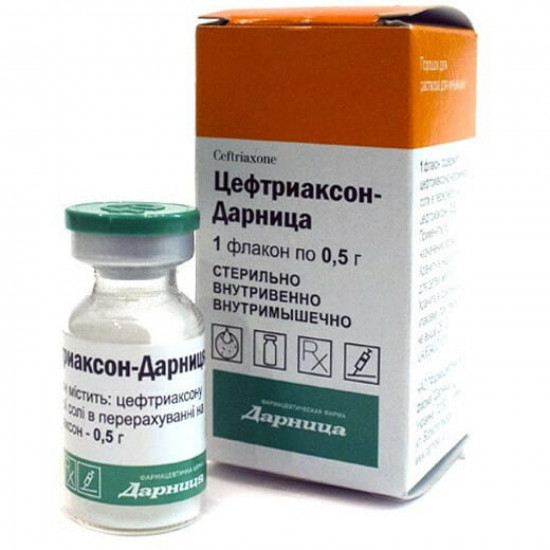
- Stock: In Stock
- Model: 179400
0% Customers recommend this product
-
5 Awesome0%
-
4 Great0%
-
3 Average0%
-
2 Bad0%
-
1 Poor0%
Reviews Over Tseftriakson-Darnitsa time. for solution for infection. fl. 0.5 g No. 1
- (0)
Total Reviews (0)
click here write review to add review for this product.
Report this review.
Description
Tseftriakson – a parenteral tsefalosporinovy antibiotic of the III generation with the prolonged action.
Microbiology . The bactericidal activity of a tseftriakson is caused by suppression of synthesis of cellular membranes. Tseftriakson is active in vitro concerning the majority of gram-negative and gram-positive microorganisms. Tseftriakson is characterized by very big resistance to the majority β-лактамаз (as penicillinases, and tsefalosporinaz) gram-positive and gram-negative bacteria. Tseftriakson is active concerning such microorganisms of in vitro and at clinical infections (see the section "Indications"):
Indications Tseftriakson-Darnits'sto apply
to treatment of infections which causative agents are sensitive to a tseftriakson: - respiratory infection, especially pneumonia and also infections of an ear, throat and nose;
- an infection of abdominal organs (peritonitis, infections of biliary tract and digestive tract);
- an infection of kidneys and urinary tract;
- an infection of genitals, including gonorrhea;
- sepsis;
- an infection of bones, joints, soft tissues, skin and also wound fevers;
- an infection at patients with the weakened host defense;
- meningitis;
- disseminate borreliosis of Lyme (stages of II and III).
Perioperatsionnaya prevention of infections at surgical interventions on bodies of digestive tract, biliary tract, urinary tract and during the gynecologic procedures, but only in cases of potential or known contamination.
At prescription of medicine needs to adhere to official recommendations about antibiotic treatment and, in particular, recommendations about prevention of an antibiotikorezistentnost.
Contraindication
Hypersensitivity to a tseftriakson or any other cephalosporin. Existence in the anamnesis of heavy reactions of hypersensitivity (for example, anaphylactic reactions) to any other b-laktamnykh type of antibacterial agents (penicillin, monobaktama and karbapenema).
Tseftriakson is contraindicated to:
Premature newborn aged ≤ 41 weeks taking into account the term of pre-natal development (gestational age + age after the birth). In the researches in vitro it was shown what tseftriakson can force out bilirubin from communication with blood serum albumine that results in possible risk of developing bilirubinovy encephalopathy at such patients.
Full-term newborn (aged ≤ 28 days):
- with a hyperbilirubinemia, jaundice, a hypoalbuminemia or acidosis as at such states the bilirubin binding is probably broken.
- who demand (or it is expected that will demand) intravenous administration of medicines of calcium or infusions of kaltsiysoderzhashchy solutions as there is a risk of formation of precipitated calcium superphosphates of calcic salt of a tseftriakson (see the sections "Features of Application" and "Side reactions").
Before intramuscular introduction of a tseftriakson should exclude surely existence of contraindications to use of lidocaine if to apply it as solvent (see the section "Features of Application"). See the instruction for use of lidocaine, especially contraindications.
Solutions of a tseftriakson containing lidocaine never should be entered intravenously.
Route of administration and doses
Adults and children since 12 years: to appoint 1-2 g of a tseftriakson of 1 times a day (each 24 hours). In heavy infections or infections which causative agents have only moderate sensitivity to a tseftriakson it is possible to increase a daily dose to 4 g
Newborns, babies and children to 12 years.
bygive the recommended doses for application of 1 times a day Below.
Newborn up to 2 weeks: 20-50 mg/kg of body weight of 1 times a day, the daily dose should not exceed 50 mg/kg of body weight. When determining a medicament dose for the full-term and premature children there are no differences.
toTseftriakson is contraindicated to newborns ≤ 28 days if necessary (or the expected need) treatments by intravenous solutions, calciferous, including constant intravenous injections which contain calcium, for example, parenteral nutrition, in connection with risk of emergence of precipitated calcium superphosphates of calcic salts of a tseftriakson (see the section "Contraindications").
Newborns and children from 15 days to 12 years: 20-80 mg/kg of body weight of 1 times a day.
byto Children with body weight more than 50 kg to appoint doses for adults.
Intravenous doses of 50 mg/kg or should be entered by infusion above within at least 30 minutes.
Overdose
Symptoms: perhaps nausea, vomiting, diarrhea, fever, a leukopenia, thrombocytopenia, sharp hemolytic anemia, skin, gastrointestinal reactions and reactions of a liver, short wind, a renal failure, stomatitis, anorexia, a temporary hearing loss, loss of orientation in space.
Treatment: to carry out symptomatic and maintenance therapy. There is no specific antidote. The hemodialysis and peritoneal dialysis are inefficient.
Special instructions
Use during pregnancy or feeding by a breast
Pregnancy.
Tseftriakson gets through a placental barrier. There are limited data on application of a tseftriakson to pregnant women. Researches on animals do not demonstrate immediate or indirect harmful effects on an embryo/fruit, peri- and post-natal development. During pregnancy, especially in І a trimester, tseftriakson it is possible to apply, only if the advantage exceeds risk.
Feeding by a breast.
Tseftriakson gets into breast milk in low concentration, but at use of medicine in therapeutic doses no influence on chest babies is expected. However it is impossible to exclude risk of developing diarrhea and fungal infection of mucous membranes. It is necessary to consider a possibility of a sensitization. It is necessary to make the decision on the feeding termination by a breast or refusal of application of a tseftriakson taking into account advantage of breastfeeding for the child and advantage of therapy for the woman.
Fertility.
byIn researches of reproductive function did not reveal signs of undesirable influence on male or female fertility.
ChildrenMedicine children can apply
according to the dosages specified in the section "Route of Administration and Doses". Ability to influence the speed of reactions at control of motor transport or other mechanisms
Corresponding researches were not conducted. Due to the possibility of such side reactions as dizziness tseftriakson can affect ability to steer vehicles or to work with mechanisms.
Structure
active ingredient: ceftriaxone;
1 bottle supports a tseftriakson of sodium salt in terms of tseftriakson 0.5 g
Excipients are absent.
Storage conditionsto Store
in original packing at a temperature not above 25 °C. To store out of children's reach.
Expiration date - 3 years.
Incompatibility
Tseftriakson-Darnits'scannot be mixed with kaltsiysoderzhashchy solutions, such as Ringera solution or Gartman's solution. It is also not necessary to apply kaltsiysoderzhashchy solutions for 48 hours after the last administration of medicine.
Tseftriakson is incompatiblewith amsakriny, Vancomycinum, flukonazoly, labetaloly and aminoglycosides.
should not be mixed with other solvents, except listed in the section "Route of Administration and Doses".
Specifications
| Characteristics | |
| Active ingredients | Tseftriakson |
| Applicant | Darnitsa |
| Code of automatic telephone exchange | J01DD04 Tseftriakson |
| Interaction with food | It doesn't matter |
| Light sensitivity | Not sensitive |
| Market status | Generic-generic |
| Origin | Chemical |
| Prescription status | According to the prescription |
| Primary packing | bottle |
| Producer | DARNITSA CIAO PHARMACEUTICAL. FIRM |
| Quantity in packing | 500 mg |
| Release form | powder for injections |
| Route of administration | Oral |
| Sign | Domestic |
| Storage temperature | from 5 °C to 25 °C |
| Trade name | Tseftriakson |

















































